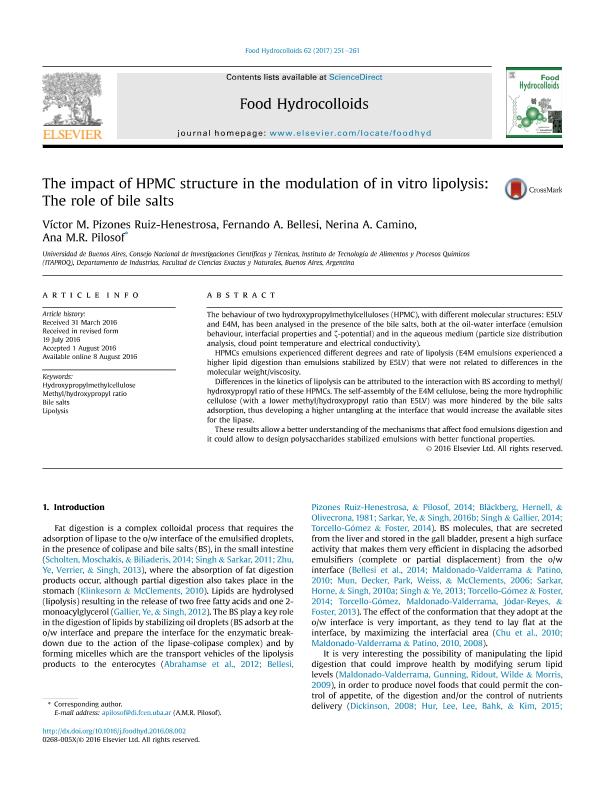Artículo
The impact of HPMC structure in the modulation of in vitro lipolysis: The role of bile salts
Pizones Ruiz Henestrosa, Víctor Manuel ; Bellesi, Fernando Alberto
; Bellesi, Fernando Alberto ; Camino, Nerina Andrea
; Camino, Nerina Andrea ; Pilosof, Ana Maria Renata
; Pilosof, Ana Maria Renata
 ; Bellesi, Fernando Alberto
; Bellesi, Fernando Alberto ; Camino, Nerina Andrea
; Camino, Nerina Andrea ; Pilosof, Ana Maria Renata
; Pilosof, Ana Maria Renata
Fecha de publicación:
01/2017
Editorial:
Elsevier
Revista:
Food Hydrocolloids
ISSN:
0268-005X
Idioma:
Inglés
Tipo de recurso:
Artículo publicado
Clasificación temática:
Resumen
The behaviour of two hydroxypropylmethylcelluloses (HPMC), with different molecular structures: E5LV and E4M, has been analysed in the presence of the bile salts, both at the oil-water interface (emulsion behaviour, interfacial properties and ζ-potential) and in the aqueous medium (particle size distribution analysis, cloud point temperature and electrical conductivity). HPMCs emulsions experienced different degrees and rate of lipolysis (E4M emulsions experienced a higher lipid digestion than emulsions stabilized by E5LV) that were not related to differences in the molecular weight/viscosity. Differences in the kinetics of lipolysis can be attributed to the interaction with BS according to methyl/hydroxypropyl ratio of these HPMCs. The self-assembly of the E4M cellulose, being the more hydrophilic cellulose (with a lower methyl/hydroxypropyl ratio than E5LV) was more hindered by the bile salts adsorption, thus developing a higher untangling at the interface that would increase the available sites for the lipase. These results allow a better understanding of the mechanisms that affect food emulsions digestion and it could allow to design polysaccharides stabilized emulsions with better functional properties.
Archivos asociados
Licencia
Identificadores
Colecciones
Articulos(OCA CIUDAD UNIVERSITARIA)
Articulos de OFICINA DE COORDINACION ADMINISTRATIVA CIUDAD UNIVERSITARIA
Articulos de OFICINA DE COORDINACION ADMINISTRATIVA CIUDAD UNIVERSITARIA
Citación
Pizones Ruiz Henestrosa, Víctor Manuel; Bellesi, Fernando Alberto; Camino, Nerina Andrea; Pilosof, Ana Maria Renata; The impact of HPMC structure in the modulation of in vitro lipolysis: The role of bile salts; Elsevier; Food Hydrocolloids; 62; 1-2017; 251-261
Compartir
Altmétricas



